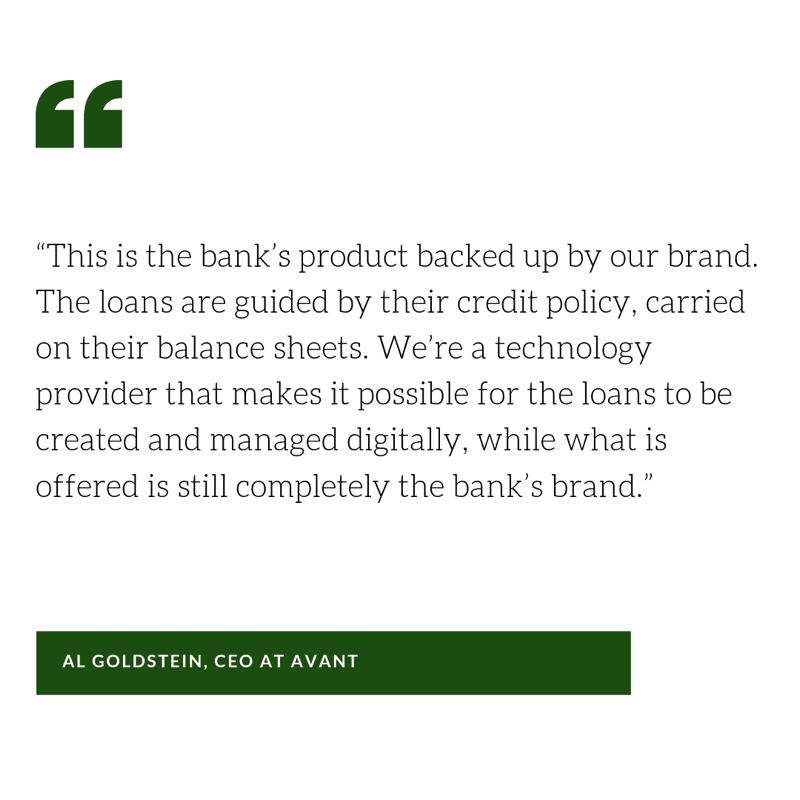
Avant is best known among its financial services peers as a FinTech firm, founded to throw automation and an artificial intelligence (AI)-enhanced underwriting process at the problem of creating accessible, affordable personal loans for consumers. Since its founding in 2012, the firm has specifically distinguished itself in a crowded field of tech-based underwriters, with its focus on the consumer group it calls the “underbanked middle class.”
The company’s target consumers have often had few accessible options, other than payday (and other short-term) lenders, when they want to borrow. Avant’s consumer-facing product is devised as a digital alternative to that market.
Potential borrowers apply online or via mobile, can be approved and offered a rate within 15 minutes, and can have their loans funded within 24 hours. Interest rates depend on the outputs of Avant’s proprietary credit-scoring mechanisms — on the higher side, borrowers will face APRs in the 35-percent range. That isn’t a small amount to pay for an installment loan, but it is far less than the triple-digit APRs that the short-term lenders and pawn shops are famous for offering.
However, while that is the best-known part of its business, that is not the only part, according Avant CEO Al Goldstein. Avant is really two businesses operating under one roof — connected in crucial ways, but separate in function. There is the consumer-facing platform (the first business), best known for making installment loans affordable for a wider range of consumers.
 Until recently, Goldstein noted, that financial institution (FI)-facing Software-as-a-Service (SaaS) business (the second business) mostly operated in the background behind the better-known part of the platform. The time has come, though, for that business line to step out and start building a real identity in the market all its own. That is why that second line, formerly a business unit known as Powered by Avant, is now stepping out with a new name — Amount — and a bigger overall purpose in the market.
Until recently, Goldstein noted, that financial institution (FI)-facing Software-as-a-Service (SaaS) business (the second business) mostly operated in the background behind the better-known part of the platform. The time has come, though, for that business line to step out and start building a real identity in the market all its own. That is why that second line, formerly a business unit known as Powered by Avant, is now stepping out with a new name — Amount — and a bigger overall purpose in the market.
A Better Option For Banks
For banks, including relatively large banks, Goldstein noted, entering into personal lending markets is daunting, even if it is appealing from a variety of standpoints. Working with smaller consumers or small business (SMB) loans isn’t profitable under labor-intensive, paperwork-heavy models that are the historical hallmark of bank underwriting systems.
However, adopting the efficiencies that digital lending platforms bring to the table isn’t as easy as just flipping a switch and moving online, he added. These are massively complicated and expensive systems to build.
Some players have built them in recent years, though, he said, noting both Goldman Sachs’ Marcus platform and U.S. Bank‘s recent rollout of an in-house, small personal loan product for their customers. U.S. Bank’s offering is very new, but Marcus has apparently been a success for Goldman — with $3 billion in loans underwritten to over 1 million borrowers.
However, Goldstein noted, not every bank has the amount of talent and capital on hand that is needed to take on a construction project the size and scope of Marcus. Even among the relatively small slice of banks that do, not all of them necessarily want to spend that time and talent on a product that will essentially be untested until it is launched. This is why, he said, partnerships between online lenders and traditional banks have become more common in recent years, particularly as both parties have realized there are customers to be reached — combining FinTech speed and efficiency in underwriting with banks’ extensive and established customer networks.
Avant launched its first bank partnership with Alabama-based Regions Bank in 2016, using its SaaS product. The company has added three others since then and noted more partnerships will be announced in the latter part of 2018. Goldstein would not name any names, but did tease that one of Amount’s first big partner announcement coming soon would be with a “top 10 U.S. bank.”
The goal in those partnership is pretty simple: let banks create the lending products they want, banked by Avant’s proprietary technology and experienced underwriting.
The matter of which banks that product will be offered to is designed to expand over time. Amount’s first target group of banks will be large institutions looking for a highly customizable lending solution. Those options will largely be full-service at first, but will contain more à la carte offerings and add-ons over time for large banks, particularly around security and consumer verification. The full-service platform will come pre-built with loan origination, verification and fraud services, decision hosting, analytics and marketing tools.
While Goldstein said Amount will start with larger banks and institutions, the goal (by 2019) will be to turn its attention to banks with fewer than $20 billion in assets. That will involve offering services that are “off-the shelf,” which are less customizable, but still “highly configurable” for smaller institutions that understand the need for full-service digital offerings for customers.
What’s Next™
The immediate term for Amount, Goldstein noted, is hiring — specifically 50 new engineers to fill out the newly create Amount business, though the new team will continue to work out of the Avant HQ in Chicago. In the long run, he would like to see Amount work on creating and re-engineering core banking systems themselves, moving them past the legacy core systems on which new infrastructures are increasingly difficult to build.
However, he remains optimistic because he believes banks see the need to change — and expand their digital toolboxes of consumer offerings. They just may not be interested in taking on everything that entails on their own.